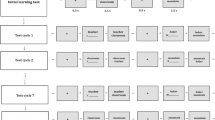Summary
Two paired-associate experiments examined conditions responsible for the free-to-cued-recall decrease phenomenon. Word class was controlled for by the use of pair elements, which could be treated alternatively as verbs and nouns. With this list material, the two experiments studied the effect of encoding conditions varying from standard, unspecified enactment instructions to enactment instructions enriched with context information. The results showed that the free-to-cued-recall decrease did not depend on motor performance, or on word class, but was much more pronounced for recency than for prerecency positions. The findings were discussed in terms of the difference between strategic and nonstrategic processing of memories of enacted information.
Similar content being viewed by others
References
Bäckman, L., Nilsson, L-G., & Chalom, D. (1986). New evidence on the nature of the encoding of action events.Memory & Cognition, 14, 339–346.
Cohen, R. L. (1981). On the generality of some memory laws.Scandinavian Journal of Psychology, 22, 267–281.
Cohen, R. L. (1984). Individual differences in event memory: A case for nonstrategic factors.Memory & Cognition, 12, 633–641.
Cohen, R. L. (1985). On the generality of the laws of memory. In L-G. Nilsson & T. Archer (Eds.),Perspectives on learning and memory (pp. 247–277). Hillsdale, NJ: Erlbaum.
Cohen, R. L. (1989). Memory for action events: The power of enactment.Educational Psychology Review, 1, 57–80.
Engelkamp, J. (1986). Nouns and verbs in paired-associate learning: Instructional effects.Psychological Research, 48, 153–159.
Engelkamp, J. (1990a).Das menschliche Gedächtnis. Göttingen: Hogrefe.
Engelkamp, J. (1990b). Memory for action events: Some implications for memory theory and for imagery. In C. Comoldi & M. McDaniel (Eds.),Imagery and cognition (pp. 183–219) New York: Springer.
Engelkamp, J., & Zimmer, H. D. (1985). Motor programs and their relation to semantic memory.German Journal of Psychology, 9, 239–254.
Engelkamp, J., & Zimmer, H. D. (1989). Memory for action events: A new field of research.Psychological Research, 51, 153–157.
Engelkamp, J., Zimmer, H. D., & Denis, M. (1989). Paired associate learning of action verbs with visual or motor imaginal encoding instructions.Psychological Research, 50, 257–263.
Greenwald, A. G. (1989). The self as a memory system: Powerful, but ordinary.Journal of Personality and Social Psychology, 57, 41–54.
Helstrup, T. (1978). Presence and absence of serial position effects.Scandinavian Journal of Psychology, 19,301–307.
Helstrup, T. (1984). Serial position phenomena: Memory for acts, contents and spatial position patterns.Scandinavian Journal of Psychology, 25, 131–146.
Helstrup, T. (1986). Separate memory laws for recall of performed acts?Scandinavian Journal of Psychology, 27, 1–29.
Helstrup, T. (1987). One, two, or three memories? A problem solving approach to memory for performed acts.Acta Psychologica, 66, 37–68.
Helstrup, T. (1989 a). Memory for performed and imaged noun pairs and verb pairs.Psychological Research, 50, 237–240.
Helstrup, T. (1989b). Loci for act recall: Contextual influence on the processing of action events.Psychological Research, 51, 168–175.
Hunt, R. R., & Einstein, G. O. (1981). Relational and item-specific information in memory.Journal of Verbal Learning and Verbal Behavior, 20, 497–514.
Puff, C. R. (1982).Handbook of research methods in human memory and cognition. New York: Academic Press.
Zimmer, H. D., & Engelkamp, J. (1989). Does motor encoding enhance relational information?Psychological Research, 51, 158–167.
Author information
Authors and Affiliations
Rights and permissions
About this article
Cite this article
Helstrup, T. Integration versus nonintegration of noun pairs and verb pairs under enactment and nonenactment conditions. Psychol. Res 53, 240–245 (1991). https://doi.org/10.1007/BF00941393
Issue Date:
DOI: https://doi.org/10.1007/BF00941393



